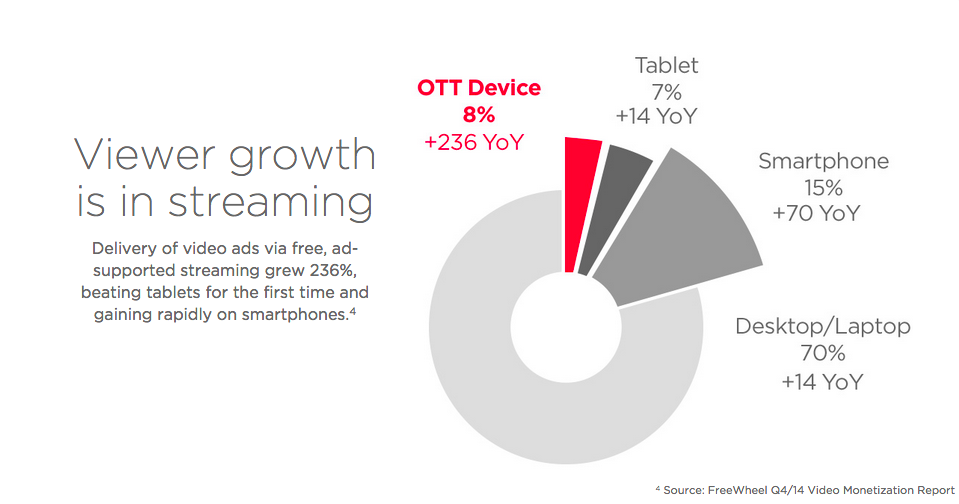Written by: Roshan Dwivedi
The average American watched nearly four hours of over-the-top (OTT) content per week in 2014, a figure that is expected to nearly double this year.
But as OTT device usage continues growing, advertisers struggle to keep pace. The current conception of OTT ads leads to undervalued inventory, but the biggest obstacle holding the sector back is the lack of unified measurement standards.
While we’re not exactly reinventing the wheel, the targeting and measurement potential of OTT goes way beyond that of network television. OTT devices can also collect data on things like app usage, purchase and downloads, all of which can dramatically increase targeting precision. So rather than reaching families in the Chicago area, for example, it’s possible to leverage demographic, behavioral and purchase data to target on an individual level.
Ad dollars will continue to follow eyeballs, shifting from traditional TV to OTT. Yet, due to the lack of standardized metrics or historical data to leverage, advertisers are finding the transition difficult.
Unfortunately, ad tech is locked in a fragmented world where sign-up is the only way to directly target to a device in a cookie-less environment. The data is there, but it’s difficult to find, and the dots are rarely – if ever – connected.
Different devices gather different types of data. Nielsen and comScore are currently the only companies, outside of first-party data, compiling this information across devices. While some marketers use third-party data to complete consumer profiles, the third-party data available isn’t very reliable yet. It’s a confusing mishmash of outlets offering small pieces of the puzzle to advertisers, ranging from pay-TV providers and media companies to TV manufacturers and OTT device companies, all of which have some access to ad inventory.
In the short term, expect fragmented data to create targeting issues across all platforms but to be incrementally solved on an individual platform-by-platform basis. The adoption of a standardized identifier and the continued investment from companies like Nielsen and comScore to compile this data into addressable groupings can and will eventually overcome this issue.
Companies like Roku have taken large strides to make their platforms more accurately addressable for advertisers. Roku has created the foundation of a unified targeting system by combining partnerships with Nielsen to create its own Roku-specific ad ID, which is comparable to the Identifier for Advertising (IDFA) in mobile, while working with publishers to understand content consumption.
This will have a sizable impact on ad revenue. Gaining the ability to target also makes it possible to personalize content and expand the level of creativity. We believe that advanced targeting across platforms will increase engagement, which will in turn make brands more willing to spend more for the right impression at the right time. Hyper-focused targeting is more valuable than spending millions of dollars for millions of impressions that reach only a handful of the right people.
As consumers switch to OTT platforms for viewing, advertising dollars will follow, making this an important trend to watch. The Diffusion Group report forecasts legacy TV advertising revenue will drop to $47.5 billion in 2018, while OTT TV ad revenue will rise to $31.5 billion during the same period. Jointly, that spells growth for the TV advertising market, even as traditional TV advertising budgets decline.
Read the entire story here.












Add your comment